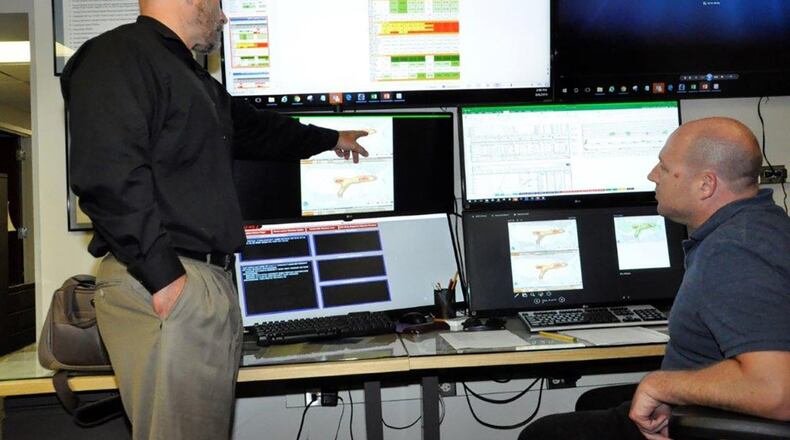When violent weather threatens the base or its missions beyond its 10-mile radius, the team of eight base meteorologists track it down first, defending Wright Patterson Air Force Base’s nearly 30,000 personnel and billions of dollars of resources from irrepressible natural enemies.
“There’s always one person sitting in that seat, 24/7, 365 days a week,” Lane said, pointing to the chair from which every Wright-Patterson weather watch, warning and advisory originates.
The Weather Flight held to that commitment when 15 confirmed tornadoes touched down in the Miami Valley, which Lane and the Air Force meteorologist overseeing operations, Scott Lutz, called the worst cluster of storms they’ve witnessed in their 27 combined years at Wright-Patterson.
Compared to the span and strength of the weather event, the slight number of lives lost in the storms amazed Lane.
“Over the course of 72 hours, there were 90 tornadoes across the Midwest – and just two fatalities,” he said. “Think about the enormity of that. It’s miraculous.”
Lane attributes that miracle to wise public decisions motivated by responsible forecasting across the area.
Lane’s team of meteorologists had been watching the storms fire to the west in a slow-moving pattern three days prior. By Monday morning, the flight had identified a four-hour window for nighttime severe weather, and by 2 p.m. severe storm potential was in the forecast. At about 9 p.m. the team put out severe thunderstorm and tornado watches.
“We issued two tornado warnings for Wright-Patt,” said Lane. “The storm cell that did most of the damage in the Prairies came within five-and-a-half miles of the base. The second didn’t drop a tornado – we didn’t report a funnel cloud or anything – but that cell, which was tornadic just to our west, tracked directly overhead.”
During events like the Memorial Day tornadoes, lives hinge on the precision of the forecasting and warning timetables. Issuing alerts too late risks leaving little time for action, but sending out a warning too soon confuses people into taking shelter early and leaving it again before the threat even arrives. Lane’s team determined the sweet spot at an 18-minute lead time, and one more minute later Wright-Patt’s Giant Voice sirens were blaring across base.
The Wright-Patt and Dayton communities listened and lost much less than the tornadoes could have taken, but Lane warns storm-chasers and naysayers against flippancy in the future.
“We try to minimize false alarms or else people get a ‘cry wolf’ mentality,” Lane said. “That does a lot of people in. They say, ‘We’ve heard them issue tornado warnings before, and we never get hit.’ I can tell you that living by that rule can get you killed.”
But even meteorologists can’t reign in or fully read the mind of the atmosphere, and like any prophet, weather forecasters receive censure when their predictions don’t come true – when storms veer or fronts shift a few miles south.
“To be a weather person, you have to forget very easily and not get offended easily,” Lane said.
“The summer severe weather season is like ‘pin the tail on the donkey’ at times,” Lutz laughed and gestured at the radar. “We will put out warnings for severe weather, and it will not occur on base. That’s just the nature of isolated storms.”
But navigating the fickleness and variance of weather is exactly why Lane, Lutz and the team love their jobs.
“The nice thing, and what I like to tell people if I’m brave enough to tell them I’m a meteorologist,” Lane said, “is that it’s different every single day.”
The flight’s decisions on severe weather go to the Air Force Materiel Command Center, which pushes them through the sirens and AtHOC, Wright-Patt’s notification system. AtHOC sends watch and warning information through e-mail and pop up alerts on work computer screens.
Personnel can also configure AtHOC to deliver alerts to their cellphones and personal e-mail addresses. To customize alerts, expand the “show hidden icons” carrot on the bottom right of your computer screen, click on the white and purple planet icon, and choose “Access Self-Service.”
About the Author
